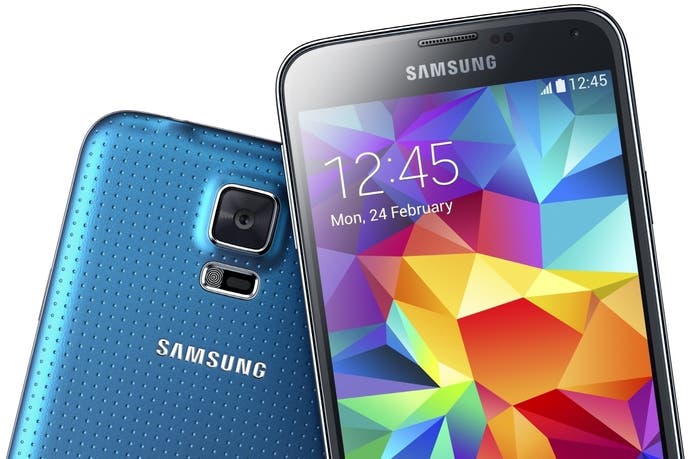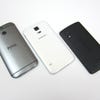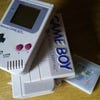Samsung Galaxy S5 review
Diminishing returns.
Samsung clambered to the top of the Android pile with the launch of the defining Galaxy S back in 2010, and has managed to repel its rivals with increasing confidence since then. The Galaxy S5 is the latest member of the family, and seeks to build on the success of previous models without scaring away the legions of fans that Samsung has amassed of late. In that regard, it's a triumph - certainly more of an evolution than a revolution - although if you're expecting any amazing innovations or life-changing features, you're going to come away distinctly disappointed. Samsung knows that it has found a winning formula in the Galaxy S range, and clearly doesn't want to tinker with it too much lest the commercial magic should somehow be lost in the process.
Let's focus on the positives for now, though. The Galaxy S5's 1080p Super AMOLED screen is nothing short of incredible, providing fantastic colour replication, deep blacks and impressive performance in direct sunlight. It's a miniscule 0.1 inches bigger than the one witnessed on the S4 - a negligible increase - but anything bigger would have pushed the phone into "phablet" territory, and Samsung already has the Galaxy Note series in that sector. The resolution is the same as the S4 - 1920x1080 - and as is the case with pretty much any top-level smartphone on the market right now, picking out individual pixels is nigh-on impossible.
With the S4 range, Samsung tried to offer an option for everyone. Alongside the standard handset, consumers were also given the choice of the S4 Zoom and the S4 Active, the latter of which was essentially the same internals as the S4 encased in a water and dustproof chassis. The good news is that Samsung has taken note of Sony's approach with the Xperia Z2 and decided to bring IP67 certification to its flagship handset, rather than presenting it as a separate alternative. While the S5 lacks the S4 Active's tough, rubber-coated casing, it will happily survive a dip in the wet stuff - although you have to be especially diligent about properly sealing the USB port and ensuring that the battery cover is always properly affixed. Thankfully, the phone flashes up on-screen reminders regarding these steps whenever you remove it from the wall charger or replace the back cover.
Speaking of which, the rear of the handset is something of a deviation for Samsung's designers; gone is the smooth, almost pearl-like plastic of the S3 and S4 and in its place is a more textured material, complete with tiny depressions which bring unfavourable comparisons with a sticking plaster. Samsung has always favoured plastic over metal when it comes to phones, but when placed alongside the metal bodies of the HTC One M8 and iPhone 5S, the company's flagship phone has never felt less like a premium proposition.
The aforementioned removable battery cover is partly to blame - it's hard to make a phone feel totally robust when the user is able to take it apart - but the fact that the entire unit is made from plastic doesn't help. The device doesn't feel solid in the hand, and when it is laid on a flat surface and a notification comes in, the vibration sounds like it's about to shake the phone apart. There are of course upsides to this situation; its construction means that the phone is lightweight, the textured back doesn't collect greasy fingermarks like the S4 does and being able to replace the battery is handy if you plan on keeping the S5 for many years, but it's hard to be too enthusiastic about another all-plastic, £500+ handset from Samsung.
The less said about Samsung's imitation of Apple's products the better, but the more sceptical among you will find it no great surprise to learn that the S5 has borrowed one of the iPhone 5S' most high-profile features: a fingerprint scanner which means only you can unlock the device. To be fair to the company, this type of security isn't exclusive to Apple and we'll surely see it deployed across the vast majority of smartphones in the next few years, but sadly Samsung hasn't been able to match its rival this time around - despite the fact that the sensor on the iPhone 5S is still far from perfect itself.
The scanner isn't as accurate as we'd like, and during our review it often failed to recognise our print. Much of this is down to the fact that unlike the iPhone 5S, the S5's home button - which houses the scanner - is an ellipse rather than circle, and therefore requires you to swipe your finger across rather than simply place it. Because this motion is needed, the margin for error increases; if you don't swipe it exactly right, it fails to register your print. You can upload multiple prints from the same digit to increase accuracy, but we found ourselves reverting back to the old pin or pattern lock simply to avoid the annoyance of failed unlock attempts.
"The Galaxy S5's 1080p Super AMOLED screen is nothing short of incredible, providing fantastic colour replication and deep blacks even in direct sunlight."
| Galaxy S5 | Moto G | Nexus 5 | Galaxy S4 | Nexus 4 | HTC One | |
|---|---|---|---|---|---|---|
| Quadrant | 24856 | 8871 | 8910 | 12346 | 4848 | 12488 |
| AnTuTu | 36749 | 16455 | 22870 | 23578 | 16333 | 24374 |
| Geekbench 3 | 2949 | 1084 | 2548 | 2190 | 1646 | 1883 |
| GFXBench 3.0 T-Rex HD | 27.1 fps (onscreen), 27.4 fps (offscreen) | 11 fps (onscreen), 5.6 fps (offscreen) | 24 fps (onscreen), 23 fps (offscreen) | 15 fps (onscreen), 15 fps (offscreen) | 19 fps (onscreen), 12 fps (onscreen) | 13 fps (onscreen), 15 fps (offscreen) |
| 3D Mark Ice Storm Unlimited | 18524 | 4430 | 16514 | 10382 | 10743 | 10602 |
Samsung's other innovation is a heart-rate sensor on the back of the phone, right next to the LED flash for the camera. This ties in with the enhanced S Health application that aims to simplify your fitness routine, allowing you to track everything from the amount of food you've ingested - and its calorie count - to the number of steps you've taken in a day. You can then share this information with other S Health users, lending your regimen that all-important competitive edge. The idea behind the sensor is that you can monitor your heart rate at certain points of the day, but to be brutally honest it's not exactly an essential hardware feature; you'll show it off to friends when you first purchase the phone but after a few weeks it will swiftly be forgotten, along with the finicky fingerprint sensor.
From the front, the S5 is almost indistinguishable from its direct ancestor, save for the capacitive buttons which flank the home button. In line with Google's directives, Samsung has finally committed the Android "menu" button to history, and in its place is the new multitasking key, which shows all of your recently-opened apps. If you're coming from stock Android, prepare to recalibrate your finger - the multitasking and back buttons have switched places on Samsung's phone.
The S5 ships with Android 4.4.2, which at the time of writing is the most recent iteration of the popular mobile OS - the same version which is currently running on Google's flagship Nexus 5 phone, no less. However, as is to be expected with third-party devices, the user interface has been heavily customised.
Samsung's TouchWiz UI has become less cartoon-like in recent years, but still lacks the finesse and sophistication of stock Android and HTC's superb Sense software. Samsung has also made some pretty sweeping changes to how Android KitKat works; for example, Google Now is no longer accessible by swiping from left to right on your default home screen. This action instead opens up "My Magazine", a custom RSS feed which basically uses the existing Flipboard application to aggregate content from a wide range of sources. It's a poor substitute for Google Now, which has become genuinely indispensable thanks to the way it supplies essential, everyday information as and when you need it. Google Now is still there, hidden behind a long press of the home button, but Samsung's decision to relegate it from its prominent position feels like a design mistake.
"The fingerprint scanner isn't as accurate as we'd like. Samsung's other innovation is a heart-rate sensor, but you'll show it off to friends when you first purchase the phone and after a few weeks it will be forgotten."
This isn't the only instance where Samsung's desire to make its UI as unique as possible damages the overall experience. Google's own Google Play storefront fights for your attention with Samsung's dedicated app store, which - confusingly for novices - offers many of the same downloads but requires you to create a Samsung account and upload your payment details a second time. S Voice tries to outdo Google Now when it comes to voice-activated commands, and Samsung's ChatON instant messaging service is in direct competition with Google's Hangouts portal. Although it's not quite as bad as Sony's Xperia UI - which also adds separate movie and music stores to the mix - it's impossible to ignore that everywhere you look there is needless duplication of functionality, and this waters down the focus of the handset and will only serve to confuse newcomers. Samsung is far from the only Android hardware maker to commit this crime, but that doesn't make the situation any less ridiculous.
Thankfully, despite the reservations about the phone's plastic-rich design and the problems thrown up by the TouchWiz UI, the technology which powers the S5 is undeniably cutting-edge. The quad-core Snapdragon 801 chipset is clocked at 2.5GHz and comes with 2GB of RAM, and this ensures that general performance is rarely less than blisteringly fast. However, that raw power sometimes doesn't translate into a convincing gaming platform.
The titles we tested are all recent 3D offerings - such as Ridge Racer Splitstream, Real Racing 3 and Frontline Commando 2 - and should, in theory at least, run smoothly on Samsung's handset. While this was generally true, we noticed slowdown and dropped frames on several games, usually during moments with a lot of on-screen activity. Some of this won't be Samsung's fault - Android games are notoriously tricky to optimise due to the sheer number of different hardware configurations available - but it's still a little disappointing that the latest and supposedly greatest Google phone doesn't handle games as well as the less powerful (on paper) iPhone 5S.
One area where Samsung has clearly worked hard is the camera - the photographic capabilities of the S5 are wonderful. Image clarity is superb, with photos showcasing plenty of detail even when you zoom in. Colour replication is also excellent, although like so many mobile phone cameras, taking shots in low light can sometimes be a lottery. Samsung's usual suite of shooting modes is present and correct, but for most users sticking with the "Auto" setting usually yields agreeable results. Video recording goes the extra mile, too - the camera can do the usual 1080p video at 60fps, but it also manages Ultra HD - that's 3840 x 2160 pixel resolution, in case you were wondering. When capturing in this mode you lose the dual camera option, HDR and video effects (which include slow and fast motion) and the option to take still images during the recording process, but if you've recently invested in a 4K television, then you'll certainly want to try this feature out.
"One area where Samsung has clearly worked hard is the revised 16-megapixel camera - the photographic capabilities of the S5 are wonderful."
Internal memory is available in 16 or 32GB flavours, depending on which model you choose to purchase. Motorola and Google may have abandoned expandable storage in their Moto G and Nexus 5 handsets, but Samsung is still keenly aware that the ability to cheaply increase the amount of storage is a big selling point for many consumers. The S5 can accept Micro SD cards up to 128GB in size, dramatically increasing the space available for music, photos and videos. Finally, it's worth mentioning that the battery life is impressive, at least for a phone with such a massive screen and a muscular quad-core processor. Samsung has included a pretty aggressive power saving mode, but even without this, it's possible to sail through an entire day without having to worry about the juice running out.
Samsung Galaxy S5: the Digital Foundry verdict
With Sony, LG and HTC all ramping up their game of late, Samsung really had to create something stunning in order to pull away from the pack, and while there are core refinements to the basic Galaxy concept, the S5 doesn't represent the assured leap many will have been hoping for. The new hardware additions - such as the fingerprint scanner and heart rate sensor - feel somewhat superfluous, and although TouchWiz has matured a little in its latest guise, it's still not as pleasurable to use as HTC's custom UI or stock Android. Samsung continues to bewilder the user by offering too many options for the same functionality, and the time spent pointlessly replicating elements which already exist in Android itself could be better spent streamlining the UI and making it more intuitive and visually appealing.
There are also issues with the build quality of the phone; a direct comparison with the HTC One M8 makes the S5 look especially poor. Samsung is charging top dollar for this handset but it simply doesn't represent a premium experience - in physical terms, at least. Under the hood the power is there, but even then, the S5 sometimes experiences difficulty converting that potential into real-world performance, especially when it comes to gaming.
Of course, many of these complaints are moot; Samsung has created a legion of loyal fans who will snap up the S5 in their millions. To some, Samsung's vision of Android - conflicted, confusing and painted in bright, primary colours, yet still possessing a universal charm - is simply the only game in town, but just as HTC discovered before the original Galaxy S appeared on the scene and stole its thunder, complacency can be deadly in the smartphone world. Samsung's next flagship phone needs to ditch the pointless gimmicks and focus more on the things that matter.
Thanks to Mobile Fun for supplying the handset used in this review.






























